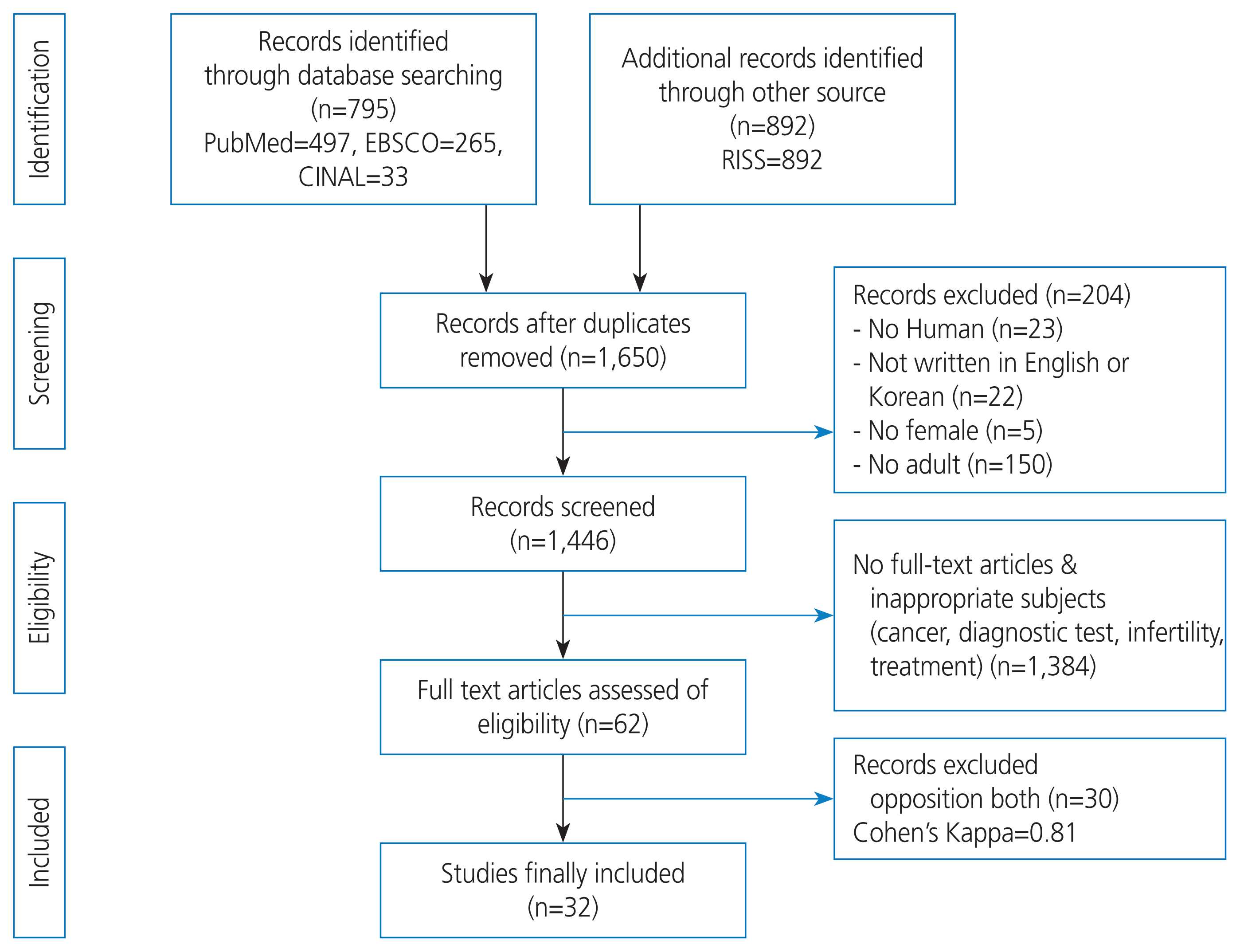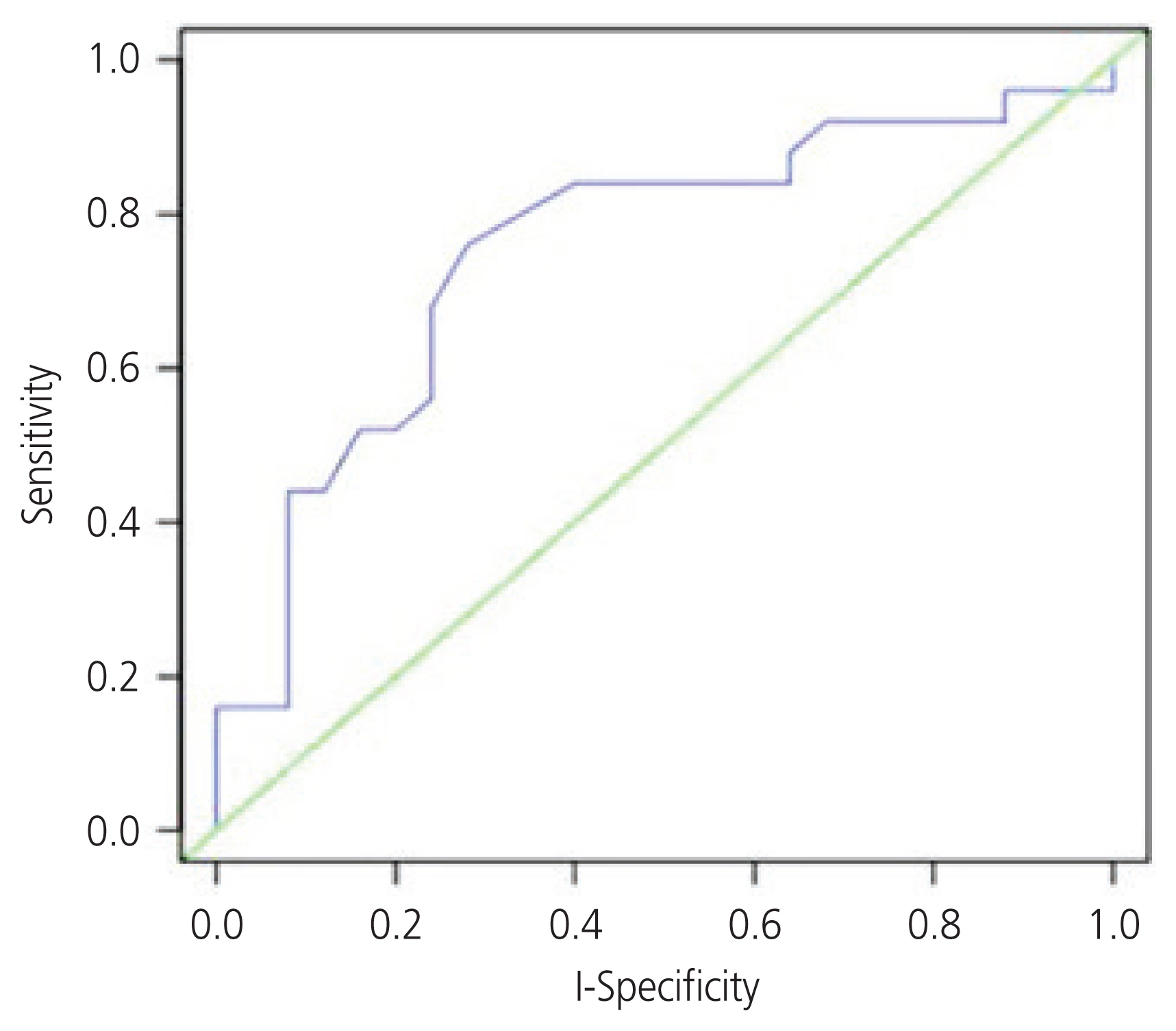Obstet Gynecol Sci.
2022 May;65(3):256-265. 10.5468/ogs.21252.
Development of an endometriosis self-assessment tool for patient
- Affiliations
-
- 1Department of Obstetrics & Gynecology, Catholic University College of Medicine, Seoul, Korea
- 2Department of Nursing, Incheon Catholic University College of Nursing, Incheon, Korea
- KMID: 2529828
- DOI: http://doi.org/10.5468/ogs.21252
Abstract
Objective
This study aimed to develop and verify an endometriosis self-assessment tool (ESAT).
Methods
A non-experimental, descriptive, correlational study design was used. Candidate items were developed based on a conceptual framework constructed using the results of in-depth interviews and an integrative literature review. The construct validity of the developed tool was also examined. One-hundred and forty-two participants (117 patients with endometriosis and 25 patients without endometriosis) were included in the validity and reliability tests. The data were collected between August and December 2018. Nomological validity was verified based on significant correlations between the ESAT and the quality-of-life scores.
Results
A 21-item ESAT was developed, and its construct validity was supported. Exploratory factor analysis indicated that the tool consisted of four components (gastrointestinal symptoms, dysmenorrhea, usual symptoms, and the amount and characteristics of menstrual bleeding) with a variance of 61.6%. The variance in quality-of-life scores, as explained by the ESAT scores, was relatively high. Receiver operator characteristics curve analysis indicated that ESAT scores significantly differentiated endometriosis from non-endometriosis with fair discriminatory power at a cut-off score of 50 (sensitivity, 0.76; specificity, 0.72; area under the curve, >0.75; P<0.001). This means that patients with ESAT scores >50 points were more likely to have endometriosis. Thus, the reliability of the ESAT was confirmed.
Conclusion
The devised tool appears valid and reliable. This tool may allow women to determine their risk of endometriosis by distinguishing between normal and pathological menstruation-related symptoms.
Keyword
Figure
Reference
-
References
1. Acién P, Velasco I. Endometriosis: a disease that remains enigmatic. ISRN Obstet Gynecol. 2013; 2013:242149.
Article2. Altman G, Wolcyzk M. Endometriosis: overview and recommendations for primary care nurse practitioners. J Nurse Pract. 2010; 6:427–34.
Article3. Schliep KC, Mumford SL, Peterson CM, Chen Z, Johnstone EB, Sharp HT, et al. Pain typology and incident endometriosis. Hum Reprod. 2015; 30:2427–38.
Article4. Yadav G, Rao M, Gothwal M, Singh P, Kathuria P, Sharma PP. Detection of nerve fibers in the eutopic endometrium of women with endometriosis, uterine fibroids and adenomyosis. Obstet Gynecol Sci. 2021; 64:454–61.
Article5. Ballard K, Lowton K, Wright J. What’s the delay? A qualitative study of women’s experiences of reaching a diagnosis of endometriosis. Fertil Steril. 2006; 86:1296–301.
Article6. Surrey E, Carter CM, Soliman AM, Khan S, DiBenedetti DB, Snabes MC. Patient-completed or symptom-based screening tools for endometriosis: a scoping review. Arch Gynecol Obstet. 2017; 296:153–65.
Article7. Culley L, Law C, Hudson N, Denny E, Mitchell H, Baumgarten M, et al. The social and psychological impact of endometriosis on women’s lives: a critical narrative review. Hum Reprod Update. 2013; 19:625–39.
Article8. Prentice A. Regular review: endometriosis. BMJ. 2001; 323:93–5.
Article9. Lee EJ. A grounded theory analysis on unmarried women’s experiences and perceptions of visit to the hospital specialized in obstetrics and gynecology. Korea Science & Art Forum. 2015; 20:349–64.
Article10. Denny E. Women’s experience of endometriosis. J Adv Nursing. 2004; 46:641–8.
Article11. Riazi H, Tehranian N, Ziaei S, Mohammadi E, Hajizadeh E, Montazeri A. Clinical diagnosis of pelvic endometriosis: a scoping review. BMC Womens Health. 2015; 15:39.
Article12. Johnson NP, Hummelshoj L, Adamson GD, Keckstein J, Taylor HS, Abrao MS, et al. World Endometriosis Society consensus on the classification of endometriosis. Hum Reprod. 2017; 32:315–24.
Article13. Gupta S, Harlev A, Agarwal A. Endometriosis: a comprehensive update. 1st ed. Cham: Springer Briefs in Reproductive Biology;2015.14. Mounsey AL, Wilgus A, Slawson DC. Diagnosis and management of endometriosis. Am Fam Physician. 2006; 74:594–600.15. Knabben L, Imboden S, Fellmann B, Nirgianakis K, Kuhn A, Mueller MD. Urinary tract endometriosis in patients with deep infiltrating endometriosis: prevalence, symptoms, management, and proposal for a new clinical classification. Fertil Steril. 2015; 103:147–52.16. Edwards M. Understanding endometriosis. Pract Nurs. 2009; 38:22–5.17. Lim YT. Current concepts in the management of endometriosis. Korean J Obstet Gynecol. 2005; 48:533–44.18. Pugsley Z, Ballard K. Management of endometriosis in general practice: the pathway to diagnosis. Br J Gen Pract. 2007; 57:470–6.19. Barber D. Endometriosis: diagnosis and management of symptoms. Community Pract. 2004; 77:227–8.20. Coleman L, Overton C. GPs have key role in early diagnosis of endometriosis. Practitioner. 2015; 259:13–7.21. Hsu AL, Sinaii N, Segars J, Nieman LK, Stratton P. Relating pelvic pain location to surgical findings of endometriosis. Obstet Gynecol. 2011; 118(2 Pt 1):223–30.
Article22. Lemaire GS. More than just menstrual cramps: symptoms and uncertainty among women with endometriosis. J Obstet Gynecol Neonatal Nurs. 2004; 33:71–9.
Article23. Lawshe CH. A quantitative approach to content validity. Persl Psychol. 1975; 28:563–75.
Article24. Seong TJ. A study on the easier statistical analysis using SPSS/AMOS. 1st ed. Seoul: Hakjisa;2007.25. Gallagher JS, DiVasta AD, Vitonis AF, Sarda V, Laufer MR, Missmer SA. The impact of endometriosis on quality of life in adolescents. J Adolesc Health. 2018; 63:766–72.
Article26. Nnoaham KE, Hummelshoj L, Kennedy SH, Jenkinson C, Zondervan KT; World Endometriosis Research Foundation Women’s Health Symptom Survey Consortium. Developing symptom-based predictive models of endometriosis as a clinical screening tool: results from a multicenter study. Fertil Steril. 2012; 98:692–701e5.
Article27. Liu L, Li C, Zhu D. A new approach to testing nomological validity and its application to a second-order measurement model of trust. J Assoc Inf Syst. 2012; 13:4.
Article28. Cox H, Henderson L, Wood R, Cagliarini G. Learning to take charge: women’s experiences of living with endometriosis. Complement Ther Nurs Midwifery. 2003; 9:62–8.
Article29. Huntington A, Gilmour JA. A life shaped by pain: women and endometriosis. J Clin Nurs. 2005; 14:1124–32.
Article30. Jones G, Jenkinson C, Kennedy S. Development of the short form endometriosis health profile questionnaire: the EHP-5. Qual Life Res. 2004; 13:695–704.
Article31. Kang H. A guide on the use of factor analysis in the assessment of construct validity. J Korean Acad Nurs. 2013; 43:587–94.
Article32. Kim JH, Shin SH, Kang HC. A case study on the use of ROC curve and AUC in the evaluation of discriminant model. J Korean Data Analysis Society. 2018; 20:609–19.
Article33. Arya P, Shaw R. Endometriosis: current thinking. Curr Obstet Gynaecol. 2005; 15:191–8.
Article34. Peterson CM, Johnstone EB, Hammoud AO, Stanford JB, Varner MW, Kennedy A, et al. Risk factors associated with endometriosis: importance of study population for characterizing disease in the ENDO Study. Am J Obstet Gynecol. 2013; 208:451e1–11.
Article35. Hediger ML, Hartnett HJ, Louis GM. Association of endometriosis with body size and figure. Fertil Steril. 2005; 84:1366–74.
Article36. Choi SY, Jun EM. Influencing factors of depression in women with endometriosis. J Korean Acad Nurs. 2005; 35:879–87.
Article37. Fernandez I, Reid C, Dziurawiec S. Living with endometriosis: the perspective of male partners. J Psychosom Res. 2006; 61:433–8.
Article38. Nnoaham KE, Hummelshoj L, Webster P, d’Hooghe T, de Cicco Nardone F, de Cicco Nardone C, et al. Impact of endometriosis on quality of life and work productivity: a multicenter study across ten countries. Fertil Steril. 2011; 96:366–73e8.
Article
- Full Text Links
- Actions
-
Cited
- CITED
-
- Close
- Share
- Similar articles
-
- Development of an endometriosis self-assessment tool for patient
- An Inguinal Endometriosis without Any Other Pelvic Endometriosis Mimicking Direct Inguinal Hernia: A Case Report
- Endometriosis of the Appendix
- Two Cases of Scar endometriosis
- The effect of serum from patients with endometriosis on mouse embryo development in vitro




